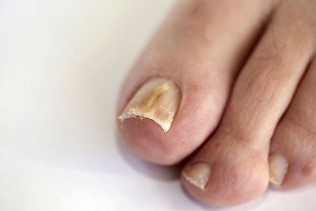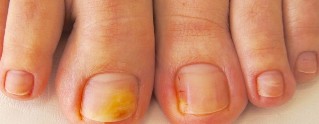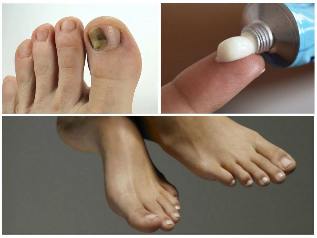Onychomycosis or fungal nail is a very unpleasant disease that is difficult to treat. The disease develops when the fungus gets under the nail plate or skin around the nail. Pathogenic microflora feed on keratin, as a result, its number is rapidly reduced and the nail is destroyed.

The causes of the disease and ways of infection
The fungus that affects the nail plate, is propagated in a humid environment with high temperature. Infected with fungus can when you visit public places with such a climate. Often the fungus lives in public showers, gyms and pools. Often, the infection occurs when visiting the beach. Another route of infection is close contact with a carrier of the infection. Catch a disease by using personal belongings of the sick person.
However, in order to obtain nail fungus, the mere contact with the agent on the skin is not enough. A strong immune system effectively suppresses pathogenic microflora and does not develop a lesion of nail plates. Factors predisposing to the development of fungus on the nails are:
- reduced immunity, both General and local;
- violation of blood circulation in the lower extremities;
- excessive sweating of the feet;
- wearing mismatched shoes, violates the blood circulation;
- damage and injuries on the skin of the feet.
The rapid growth of pathogenic organisms is often observed in the circulation, caused by a number of diseases and metabolic disorders. To provoke disease also can the wrong shoes, wearing which increases the perspiration and blood circulation. Favorable environment for development of pathogenic microflora is the wet skin, which is not receiving enough oxygen. It happens when a man wears socks of synthetic fabrics and narrow shoes, made of faux "not breathing" materials.
Another reason which can trigger the development of infection is the disregard for the rules of hygiene and not following the safety measures. The patient may inadvertently "to" fungus – trying on someone else's shoes, visiting the public pool or shower without Slippers, or using someone else's towel for the feet.
Often people make a serious mistake when buying new shoes – they try on her bare feet not using socks. Such action can cause nail fungus because don't know who tried the same pair of shoes before and was not the feet of the man infected with pathogenic microflora.
How to recognize the disease?
When nail fungus on the feet, the symptoms are so characteristic that to confuse this disease with other diseases is very difficult. In order to identify a pathology, it is necessary to know its main features, including:

- the formation of spots and stripes under the nail plate;
- white muddy color of the nail.
- inflammation and dryness of the skin on the finger around the affected nail;
- the plaque mold;
- fragility and change in the structure of the nail plate.
Initial symptom of the disease is the formation of stripes or spots, of greenish or yellowish color. These strips go deep in the thickness of the nail plate and gives the impression that they are on the skin under the nail.
Usually primarily affects the big toenail, at least – on the little finger. At the initial stage of the disease on the fungus only shows the color change of the nail plate and the characteristic spots and stripes. After some time, the infection affects other fingers, redness, flaking and itching of the skin around the nails.
The treatment of the disease at this stage allows you to effectively and quickly get rid of the fungus, however, patients rarely seek help from a doctor, noticing similar symptoms.
With the increase in the population of pathogenic microflora, the fungus begins to destroy the surface of the nail plate. It is characterized by the fact that the nail becomes soft and with mounds, in cracks and hollows, the structure becomes heterogeneous. This may be accompanied by pus from under the nail and a sharp unpleasant odor from the feet. Over time, the fingernail is destroyed, the peeling becomes stronger and affects the skin between the toes.
Looks like the defeat of the nail depends on the type of fungus. The causative agent most often is a yeast or fungi. During infection a yeast nail plate acquires a grayish-bluish color. The nail is quickly destroyed and as a result completely departs from the nail bed.
Molds fungi affect the nail plate in case of violation of nutrition of tissues, for example, as a result of strong compression of the nails too tight shoes. For this type of onychomycosis is characterized by the formation of white patches on the nails.
Knowing how the disease, it is crucial to visit a doctor. Different types of fungus have different symptoms and treatment that is difficult to guess on their own, without consulting a specialist.
The principle of treatment
Treatment of lesions of the nail plate requires a comprehensive approach and takes a long time. It is important to remember that the sooner identified the symptoms of the fungus and treatment is started, the faster you will be able to get rid of the disease.
To combat the disease are used:

- antifungal ointments and solutions;
- systemic antifungals tablets;
- traditional medicines.
To correct the pathology at the initial stage by using external antifungals. Such preparations include ointments, solutions, as well as lacquers with antifungal component in the composition.
For the treatment most often prescribed ointment broad-spectrum components that actively affect a variety of fungi, including yeast. Ointments and creams are better to use in the initial stage of the disease. In violation of the structure of the nail plate they are ineffective, because the components of the drug can penetrate into small cracks of the nail.
Most effective are antifungal drugs in solutions. Such drugs are usually produced in the bubbles with a pipette. The product is applied to the nail plate. Thanks to the liquid consistency, the substance fills in the slightest irregularity and gets under the nail plate, thereby effectively acting on the affected area.
Pharmacies are widely represented products in the form of varnish. The peculiarity of this form of antifungal drugs is that they do not need to use daily. Varnish is applied every few days. The drug forms a protective coating on the nail plate, thus protecting the nail and inhibiting the spread of fungal infection. The active substance of the drug penetrate into the nail plate and are long lasting – one application is sufficient to provide antifungal activity over two days. Coatings are also effective for the prevention of fungal diseases. You can use them once a week or apply before visiting places with high risk of infection by the fungus.
In addition to processing of the nail plate, it is necessary to provide antifungal protection for skin around the nail and between the toes. To do this, use the ointment.
If the nails have started to break down, preparations for external application is not enough, so additionally appointed antifungals in pill. These chemicals have systemic effects on the whole body.
If fungal nail is accompanied by bacterial infection, in which the appearance of pus, in addition prescribe ointments with antibacterial action, for example, Levomekol.
In folk medicine, used such remedies against onychomycosis.

- A mixture of Apple cider vinegar and water is applied on a gauze compress, which is applied to the affected nail for 1 hour. The procedure is repeated daily for two weeks.
- Squeeze the juice of one lemon mixed with two spoons of water. Solution should be used for treatment of the affected nails twice a day.
- In a foot bath, add two large spoons of baking soda and iodized or sea salt. Foot placed in a tub for half an hour. The procedure is performed daily at bedtime.
Further treated the nails with the juice of onion or propolis tincture. Folk remedies it is recommended to use in conjunction with antifungal medications that are prescribed by a doctor.
Severe stage of fungal infection leads to loss of the nails, so it is important to promptly contact a specialist at the first symptoms of the disease.





























